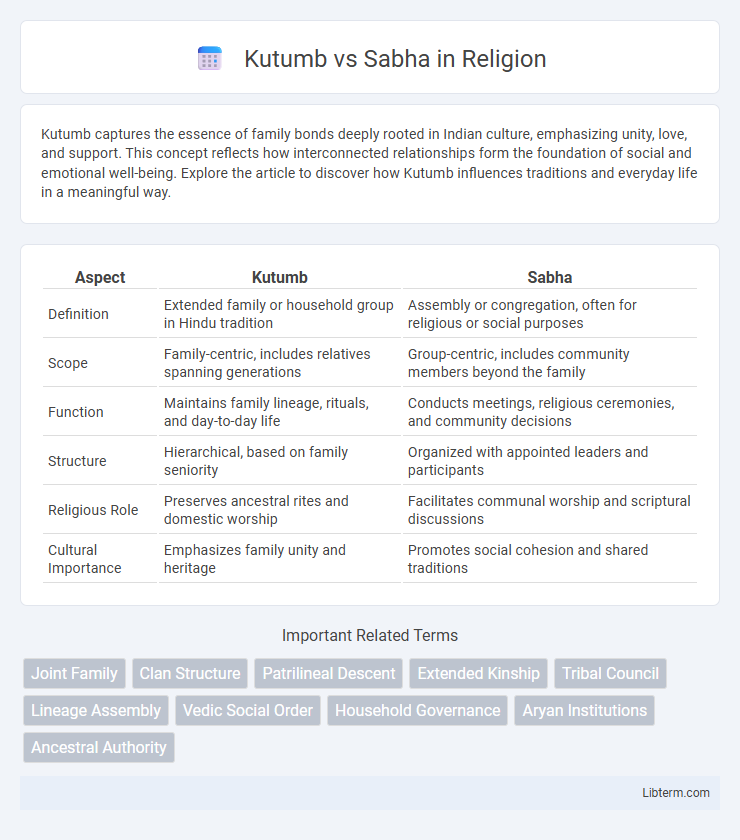Kutumb captures the essence of family bonds deeply rooted in Indian culture, emphasizing unity, love, and support. This concept reflects how interconnected relationships form the foundation of social and emotional well-being. Explore the article to discover how Kutumb influences traditions and everyday life in a meaningful way.
Table of Comparison
| Aspect | Kutumb | Sabha |
|---|---|---|
| Definition | Extended family or household group in Hindu tradition | Assembly or congregation, often for religious or social purposes |
| Scope | Family-centric, includes relatives spanning generations | Group-centric, includes community members beyond the family |
| Function | Maintains family lineage, rituals, and day-to-day life | Conducts meetings, religious ceremonies, and community decisions |
| Structure | Hierarchical, based on family seniority | Organized with appointed leaders and participants |
| Religious Role | Preserves ancestral rites and domestic worship | Facilitates communal worship and scriptural discussions |
| Cultural Importance | Emphasizes family unity and heritage | Promotes social cohesion and shared traditions |
Introduction to Kutumb and Sabha
Kutumb and Sabha represent two traditional social structures in Indian society, with Kutumb referring to the extended family unit encompassing multiple generations living together, emphasizing close kinship ties and shared responsibilities. Sabha denotes an assembly or council, often comprising community members or elders, functioning as a decision-making body for resolving disputes or managing communal affairs. Understanding Kutumb highlights the importance of familial bonds, while Sabha illustrates collective governance and social organization within villages or communities.
Historical Background and Evolution
Kutumb and Sabha represent distinct social structures in ancient Indian society, with Kutumb referring to the extended family unit central to early community life, and Sabha denoting an assembly or council often linked with governance and decision-making. The concept of Kutumb evolved from tightly-knit kinship groups essential for agricultural and domestic tasks, while Sabha emerged during the Vedic period as a formalized gathering for political, judicial, and religious activities. Historical texts like the Rigveda and Dharmasastras document both entities, highlighting how Kutumb laid the foundation for social organization, whereas Sabha influenced the development of early democratic institutions.
Definition and Core Functions
Kutumb refers to an extended family system in Indian culture, emphasizing kinship bonds and collective responsibilities within a household. Sabha denotes a formal assembly or council in ancient Indian governance, primarily tasked with decision-making, dispute resolution, and maintaining social order. While Kutumb centers on familial relationships and mutual support, Sabha functions as a larger community forum for administrative and judicial purposes.
Structure and Membership
Kutumb is a traditional Indian family structure encompassing multiple generations living together, often including grandparents, parents, children, and extended relatives under one roof, emphasizing close-knit relationships and collective responsibility. Sabha, on the other hand, refers to an assembly or council typically composed of elected or appointed members representing a community or organization, with a formalized structure and roles such as president, secretary, and treasurer. Membership in a Kutumb is based on blood relations and familial ties, whereas Sabha membership is defined by selection criteria, eligibility, or community representation.
Decision-Making Processes
Kutumb represents a family-based decision-making process where choices are influenced by close kinship ties and collective consensus within the household unit. Sabha operates on a broader community level, involving deliberation and voting among diverse members to reach decisions that affect the larger group or village. The key distinction lies in Kutumb's emphasis on intimate relationships versus Sabha's structured communal participation.
Role in Ancient Indian Society
Kutumb functioned as the fundamental family unit in ancient Indian society, emphasizing kinship ties and joint family responsibilities for social stability and economic cooperation. Sabha served as a broader assembly or council, often composed of elders or leaders, tasked with governance, dispute resolution, and decision-making in village or regional communities. The complementary roles of Kutumb and Sabha ensured cohesive family support systems alongside organized communal governance in ancient Indian social structures.
Comparison: Governance and Authority
Kutumb refers to the family unit, primarily governed by elders who exercise authority based on kinship ties, traditions, and age, making decisions that directly affect family members' welfare and daily life. Sabha, on the other hand, is a formal assembly often associated with governance in ancient Indian contexts, involving collective decision-making by representatives or community leaders, emphasizing structured political or social authority beyond immediate kinship. The key distinction lies in Kutumb's informal, lineage-based governance versus Sabha's institutionalized, participatory authority system.
Cultural and Social Significance
Kutumb represents the traditional Indian joint family system, emphasizing close kinship bonds, collective decision-making, and shared responsibilities, which foster strong family values and cultural continuity. Sabha refers to an assembly or council often found in ancient and contemporary Indian society, serving as a platform for communal discussions, governance, and social organization, reflecting democratic principles embedded in cultural practices. Both Kutumb and Sabha are integral to Indian social structure, with Kutumb focusing on familial unity and Sabha highlighting community participation and social governance.
Changes Over Time
Kutumb and Sabha represent evolving social structures in ancient Indian society, with Kutumb referring to the extended family unit and Sabha denoting an assembly or council. Over time, the role of Kutumb shifted from a primarily familial and economic unit to a more complex entity influenced by changing social norms and inheritance patterns. Sabha transformed from informal gatherings of elders to formalized institutions involved in governance and judicial functions, reflecting increased political organization and social stratification.
Legacy and Modern Relevance
Kutumb represents the traditional Indian joint family system emphasizing collective living and shared responsibilities, fostering strong kinship bonds and cultural continuity across generations. Sabha, historically a council or assembly in ancient India, embodies organized governance and community decision-making, reflecting democratic principles that have influenced modern administrative frameworks. The legacy of Kutumb highlights the importance of familial unity and social support, while Sabha's modern relevance persists in local governance bodies and participatory democracy models, bridging ancient practices with contemporary societal structures.
Kutumb Infographic

 libterm.com
libterm.com